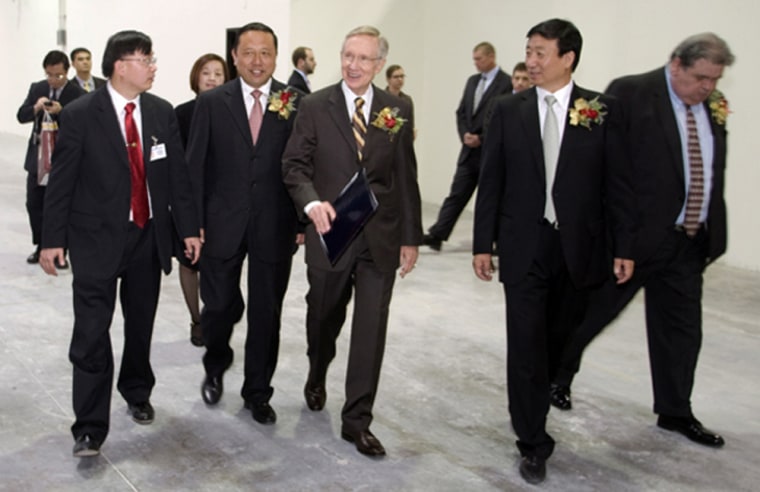Top Democratic fundraisers and lobbyists with links to the White House are behind a proposed wind farm in Texas that stands to get $450 million in stimulus money, even though a Chinese company would operate the farm and its turbines would be built in China.
The farm’s backers also have close ties with Senate Majority Leader Harry Reid, D-Nev., who, at the height of his hard-fought re-election bid this fall, helped blunt congressional criticism over stimulus dollars possibly going to create jobs in China by endorsing a proposal by the Chinese company to build a factory in his home state. Although his campaign received thousands of dollars in donations from the wind farm’s backers and Reid stood on stage with them at a campaign event they hosted, his office declined to answer any questions about the wind farm’s organizers or their plans for Nevada.
The wind farm, first announced more than a year ago, would consist of 300 2-megawatt wind turbines, each perched atop a 26-story-tall steel tower and spinning three blades — each half the length of a football field. The farm would span three counties and 36,000 acres in West Texas land best known for its oil. Dubbed the Spinning Star wind farm, the project’s 600-megawatt capacity is, theoretically, enough to power 180,000 American homes and would be the sixth-largest wind farm in the country.
It is being planned by an unusual joint partnership between the U.S. Renewable Energy Group, a Dallas investment firm with strong ties to Washington and the Democratic Party, and A-Power Energy Generation Systems, an upstart Chinese supplier of wind turbines. Filings with the Securities and Exchange Commission indicate the Chinese are bringing financing and the turbines.
What the Americans are supplying is the local know-how and political clout in Washington, where decisions on how to distribute billions in loan guarantees, stimulus grants and financial incentives are made.
The clock is ticking for Spinning Star: To claim the stimulus grant it must arrange its financing and begin work on the wind farm by Dec. 31. Besides the $450 million stimulus grant, A-Power’s SEC filings indicate the joint-venture also will pursue a Department of Energy-backed loan guarantee. According to the SEC filings, the project is waiting to hear if it will receive the loan guarantee before financing will follow to build the turbines.
Powerful donors to Democrats
The investment group’s public face is often Cappy McGarr, a wealthy Texas philanthropist, investor and longtime fixture in Democratic politics, who has given heavily to Democratic candidates across the country and was an early backer of President Barack Obama’s presidential campaign. Joining McGarr in Dallas is Ed Cunningham, a former executive for several large Western entertainment companies in China, a 2002 Democratic senatorial candidate and a former member of Obama’s national finance committee.
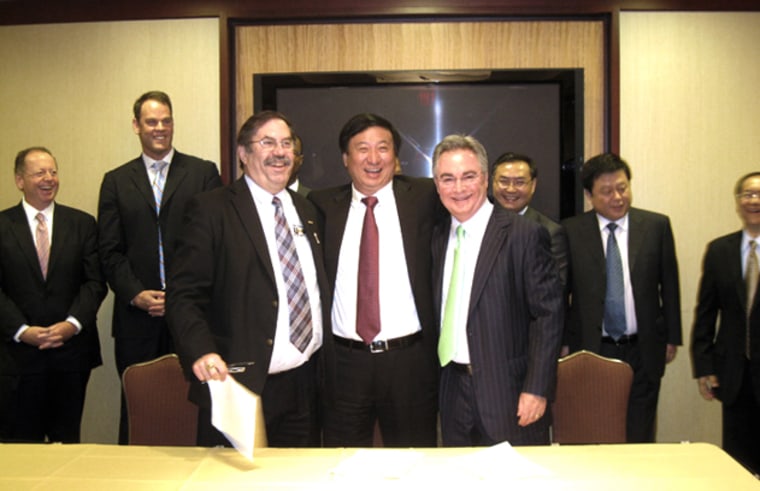
Two registered lobbyists with a long history of involvement in Democratic politics, G. John O’Hanlon and Moses Boyd, are the group’s anchors in Washington. O’Hanlon has been a party operative since the 1980s — a protégé of Democratic heavyweight Terry McAuliffe — and has given hundreds of thousands of dollars to Democratic causes. Boyd is a former senior Democratic Capitol Hill staffer turned lobbyist.
McGarr married into Democratic Party royalty — his wife’s uncle is legendary Democratic power broker Robert Strauss — and has made his own name as a big-time donor to the party and candidates across the country. McGarr and his wife, Janie Strauss McGarr, have given more than $375,000 to various Democratic candidates and political action committees since 2006, according to Federal Election Commission records. That doesn’t include the $50,000 he donated to Obama’s inauguration and $50,000 to $100,000 in donations from others that he “bundled” for the Obama campaign.
All told, these four and their spouses have given more than $1.8 million in campaign donations since 1990, with McGarr and his wife accounting for more than half of that.
“That would place them among the top 100 donors of hard money overall,” said Sheila Krumholz, executive director of the Center for Responsive Politics, an independent research group that tracks campaign finance and how it affects elections and public policy.
The important question, however, is not how much they have given, Krumholz said, but "What does this buy them with each individual target of their largesse?”
The money that McGarr “bundled” in the last election — essentially working on a volunteer basis to solicit money for the Obama presidential campaign — is particularly significant, she said. It’s an important and valuable role to play in a campaign, she said, and one that typically is acknowledged.
“In some cases,” Krumholz said, bundlers, “maybe are just making very little effort and are ideologically driven, but in many, many cases, historically, these people are looking for access to tap in on. It should not be presumed that this is uninterested work.”
White House visits
McGarr’s connections and party loyalty do seem to open doors for him in Washington — and at the White House. McGarr visited the White House at least eight times in the administration’s first 18 months in office, according to visitor records disclosed by the White House. (These disclosures are voluntary, and do not include meetings held with staff outside of the White House, telephone contacts or records that the Obama administration has not released from its first nine months.) Three of the visits were for large social functions hosted by the president, but four were occasions when he met with senior White House staff and presidential advisers.
On Sept. 15, 2009, just weeks before he announced his new renewable energy venture that would tap Obama’s stimulus plan for hundreds of millions of dollars, McGarr met with Pete Rouse, one of three “senior advisers” to the president. Rouse was named acting chief-of-staff in October 2010 after Rahm Emmanuel announced his departure. Rouse was formerly the chief-of-staff for former Democratic Senate leader Tom Daschle. McGarr is the chairman of Daschle's political action committee.
Obama White House won't answer questions
Liz Oxhorn, a White House spokesperson for the Recovery Act, declined to answer questions about what was discussed during that meeting or any other — including whether Rouse and other White House officials know about the Spinning Star project or were asked to intervene on its behalf.
“Competitive Recovery Act funds are only awarded by experts at federal agencies following an internal merit-based review process,” she said in an e-mail, denying the White House had intervened in the process to award a loan guarantee.
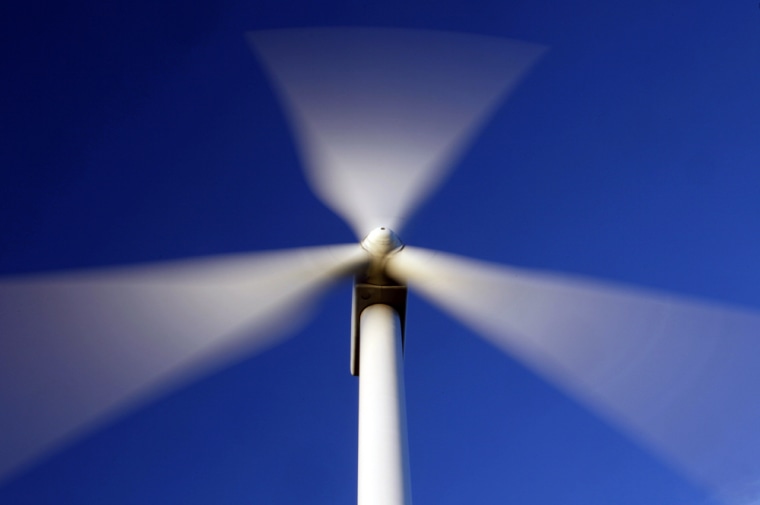
Patrick Dorton, a spokesperson for U.S. Renewable Energy Group, the U.S. partner in the windmill project, said neither McGarr nor any other member of the group ever asked the White House to intervene on behalf of their project.
“US-REG has not asked any official in any branch of government to advocate on behalf of their project in the DOE loan guarantee process,” Dorton said. “This is a project that stands on its own merits.”
Most of McGarr’s visits were related to his work as executive producer of the Library of Congress’ Gershwin Prize for Popular Music, which honored Stevie Wonder in 2009 and Paul McCartney this June, Dorton said in an e-mailed statement. Dorton also said a meeting at the White House in January attended by Boyd was for his involvement with a group lobbying for a renewable energy standard — a proposed federal requirement that a certain percentage of electricity come from renewable sources — but neither US-REG nor Spinning Star were mentioned.
A $245 million 'developer fee'
According to Dorton’s statement, the four partners in US-REG each brought particular strengths to the deal: Cunningham has negotiated business deals in China; McGarr has worked in private equity; and O’Hanlon and Boyd have experience with green energy. That all four men are prominent in Washington and Democratic circles has nothing to do with their partnership, Dorton said.
Together, McGarr, Cunningham, O’Hanlon and Boyd will own 51 percent of the Spinning Star wind farm, according to the joint venture agreement filed with the SEC by A-Power. But to earn that ownership stake in a project whose ultimate value is estimated at $2 billion, they won’t have to contribute any significant financial investment of their own.
What US-REG must do to earn its “developer fee,” which SEC documents suggest could be worth as much as $244.8 million, is secure “all project rights, beneficial contracts, permits, permit applications and Consultant Information.”
At an Oct. 29 press conference to announce the new joint venture, the top Chinese A-Power executive made it clear what each company in the deal needed to do to make their new project go forward.
“To go deep and broader in our cooperation in clean energy, Shenyang Power Group and US-REG and (construction contractor) Cielo Wind must focus on execution and leveraging our relations with the respective governments of our two great nations,” Jinxiang Lu, A-Power’s CEO, said through a translator. Shenyang Power is a subsidiary of A-Power.
Who is A-Power?
A-Power Energy Generation Systems is a small Chinese manufacturer, founded in 2007 as China’s interest in green energy was beginning to take off. Like most Chinese green-energy equipment manufacturers, A-Power obtained most of its technology from companies outside of China — specifically, German wind turbine company Fuhrlander and General Electric (Msnbc.com is a joint venture between Microsoft and NBC Universal. GE is the parent company of NBC Universal). But what A-Power lacks in original or cutting-edge technology it makes up for in the apparent ability to summon the brute force of China’s newly developed manufacturing base.
The company is based in Shenyang Province, a small northeastern province on the border with North Korea that has recently become a hub for Chinese manufacturing. Aside from a handful of deals in Southeast Asia, A-Power has supplied relatively few turbines, but claims to have the largest turbine factory in China, poised to build hundreds a year.
On Sept. 29, a website owned by an A-Power subsidiary published pictures showing a ceremony and parade for what company officials said is the first turbine to be shipped to Texas, but in later filings with the SEC, the company said no turbines had been constructed.
Some financing for the project may come from the Chinese Export-Import Bank, a Chinese government-backed agency set up to help finance deals that will help promote Beijing’s export policy, according to other press releases on the same company website.
Related: Follow the money on the Stimulus Tracker
But according to SEC filings by the company made last week, getting financing for the deal may hinge on whether the Department of Energy is willing to guarantee the loan. US-REG’s spokesman said the project has made it through the first phase of the loan guarantee program, but a Department of Energy spokesperson cautioned that, to date, the administration hasn’t give the project anything.
“The project has not received a single dime of Recovery Act funding,” a Department of Energy statement said. “It has not applied for a tax grant under the 1603 program, has not completed the loan application process and has not been awarded a loan guarantee.”
How Washington friends can help
US-REG's ability to help its new Chinese partners associate themselves with the Washington power players can be traced through a series of recent deals announced by the two companies in the year since they unveiled plans for the Spinning Star Wind Farm.
Shortly after that announcement, the proposed project began inciting a kind of populist backlash. Several U.S. senators, led by Charles Schumer, D-N.Y., attacked the proposed plan in November as a misuse of U.S. stimulus dollars. US-REG originally predicted that the Spinning Star wind farm might create as many as 2,800 jobs — the vast majority being in China where the turbines would be built. As few as 40 long-term jobs might be created in the U.S., a point that Schumer hammered at.
A friend in the Senate, a friend for the senator
In November 2009, US-REG and A-Power announced a new deal, this one apparently carefully crafted to counter the charges that the only thing the project would yield was Chinese jobs. A-Power would build a new manufacturing facility — in Nevada. The new plant would employ 1,000 workers and manufacture turbines for the U.S. market. The factory proposal had virtually no details, such as where it would be, or how A-Power expected to sell turbines in the already competitive U.S. market when they were removing the biggest selling point in their business plan: cheap Chinese labor.
But it was still heartily endorsed at the time by Harry Reid, the Senate majority leader.
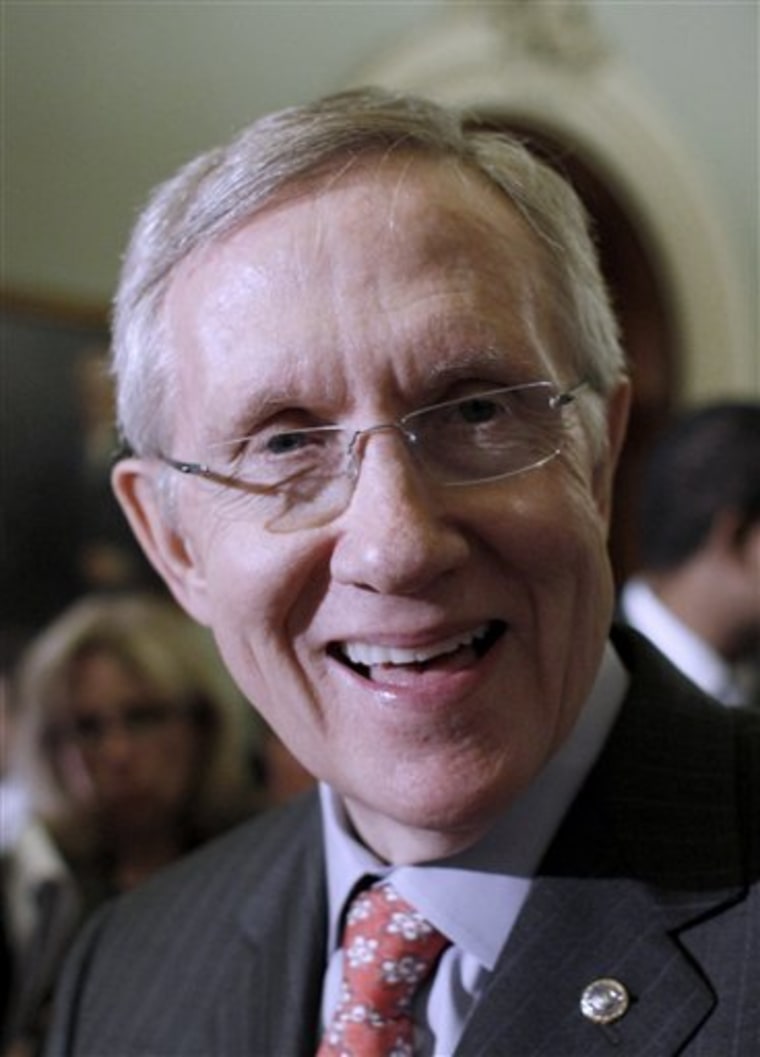
Representatives from US-REG and A-Power took pains to praise Reid, who was locked in a tight race to retain his seat, for his foresight and interest in creating green-collar jobs for Nevada. It was a winning situation for everyone involved.
But on March 3, 2010, Schumer and four other Democratic senators introduced an amendment to the stimulus package that attempted to apply the law’s Buy American provision to the Section 1603 grant program, which would pay out the $450 million to the Spinning Star wind farm.
A newspaper family joins the project
Eight days later, on March 11, a news conference was held by the Spinning Star partners, again beating the drum for a new turbine factory in Nevada. Though the new announcement offered few new details, it did have another new partner — the real estate firm owned by the Greenspun family of Las Vegas, which besides being vocal in support of Harry Reid also owns the Las Vegas Sun newspaper. The newspaper published an op-ed by Brian Greenspun lauding Reid for his role in the midst of a tough election fight to lure a project with such massive job creation potential to Nevada.
On March 18, Moses Boyd wrote a check for $29,940 to the Democratic Senatorial Campaign Committee. The committee, controlled by Senate Democratic leadership, contributed $65,000 to Reid’s campaign after he added his endorsement to the A-Power project. On March 22, Boyd, O’Hanlon and two other members of their lobbying firm gave $4,900 in campaign contributions to Reid.
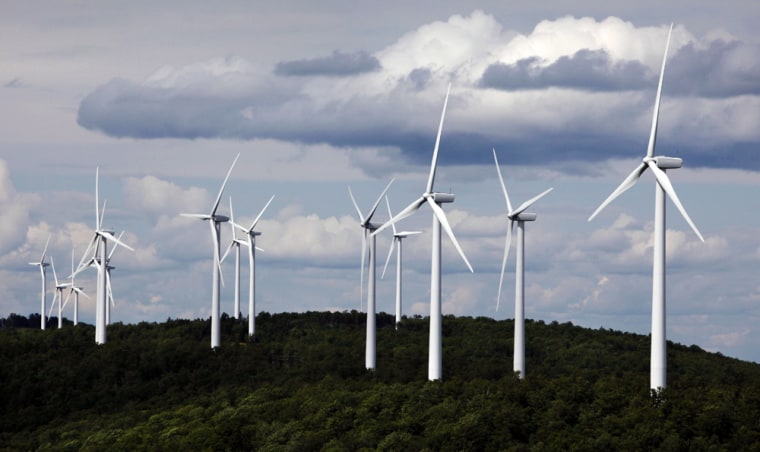
Another press event promoting the proposed Nevada factory was held in April. This time it was a symbolic ribbon-cutting ceremony. Again, there were no new details, but Reid’s endorsement was prominently featured, and Secretary of the Interior Ken Salazar appeared at the event. In June, Boyd and two other registered lobbyists at his firm made another $1,400 in donations to Reid’s campaign.
On Oct. 12, the cooperative relationship between Reid and the Spinning Star wind farm partners culminated with a splashy campaign event for the Senate leader, hosted by Cappy McGarr. The event, held at a newly opened LED manufacturing plant in Henderson, Nev., owned by an unrelated company from Singapore, and which A-Power declared was its new temporary headquarters, featured Reid taking the stage between McGarr and A-Power CEO Lu and a Communist Party official from Shenyang.
Reid's office won't answer questions
Reid’s office declined to answer any questions about A-Power and US-REG despite multiple requests for comment. Dorton, the US-REG spokesman, flatly denied there was any connection between US-REG’s hefty campaign donations and Reid’s support. It was Reid who approached US-REG about locating in Nevada, he said.
“Once he and his staff learned A-Power was searching for a site to build a wind turbine assembly facility, they presented Nevada as an option,” Dorton said.
Krumholz of the Center for Responsive Politics said this type of relationship — large donors with specific business needs establishing a relationship with a powerful politician who can help — is quite common.
“It’s not out of the ordinary, but it may raise eyebrows,” Krumholz said.
In this instance, she said, the two sides appear to have each had something specific to offer the other.
“It was helpful to Reid to say, ‘We’ll help you raise money. We’ll serve up victory on a silver platter for you. We’ll bring green jobs to the state,’” Krumholz said. “It’s like a ready-made campaign platform — and it was accompanied by real dollars.”
And the importance of getting Reid’s endorsement for their project cannot be overemphasized, she said.
“To get the sanction of the most powerful man in the Senate — it’s priceless,” Krumholz said. “To say they have received his blessing will go a long way in Democratic circles.”
The members of US-REG, including registered lobbyists O’Hanlon and Boyd, did go to Capitol Hill to promote their project, urging lawmakers not to support Schumer’s amendment, Dorton said. Registered lobbyists are required to report their contact with members of Congress and government agencies, but neither O’Hanlon nor Boyd reported lobbying for US-REG. Dorton acknowledged that US-REG’s members have gone to the Hill to talk about their project, but said there was no conflict of interest and all legally required disclosures have been made.
A hand from the Steelworkers
To further bolster the credibility of the Spinning Star project, the US-REG principals also sought to calm critics from the left.
The United Steelworkers labor union initially opposed the possibility of any stimulus dollars going toward the Spinning Star wind farm, based on the plan to import the turbines from China. But in August, the union, which is typically one of the most stalwart supporters of Democratic causes and had previously supported Schumer’s amendment, suddenly made an about-face. Leo W. Gerard, the union’s president, announced he had signed an agreement with A-Power to ensure that the steel used in the Spinning Star project came only from American steel mills employing union workers.
A representative from the Steelworkers did not reply to a request for comment, and Dorton referred questions about this deal to a press release issued by the Steelworkers in August. In the release, both A-Power’s Chinese executives and Gerard make it clear that it is US-REG that brought them to the table.
“Through our partnership with U.S. Renewable Energy Group, we had the unique opportunity to meet President Gerard and understand his vision,” said Lu, the A-Power CEO.
Noting it was the first time that the Steelworks teamed up with a Chinese company, Gerard heaped praise on, “the expertise and insight of Cappy McGarr and Ed Cunningham of the U.S. Renewable Energy Group who brought together this landmark cooperation.”
Photos of a signing ceremony show all four members of US-REG watching Gerard and A-Power CEO Lu Jinxiang embrace.
Because of the sheer size and weight of wind turbine towers — each one can weigh hundreds of tons — the likelihood that they would be imported to Texas from China was low to begin with, but the endorsement of the USW brought credibility to the project. It did nothing to change the fact that the most expensive, and labor-intensive, part of a turbine, the nacelle, will still come from China.
The Chinese gain another friend, the former DNC chairman
A-Power, the Chinese company, has found other friends in the Democratic Party, including at least prominent one with links to US-REG.
In August, A-Power signed a new joint-venture agreement with Terry McAuliffe, the former chairman of the Democratic National Committee and one of the party’s leading power brokers. US-REG’s spokesman said none of the partners had anything to do with McAuliffe’s deal with A-Power.
Throughout his career in Washington, US-REG partner John O’Hanlon has frequently found himself working closely with McAuliffe. McAuliffe and O’Hanlon both did stints with the Democratic Congressional Campaign Committee in the early 1980s and worked in fundraising for former Democratic presidential candidate Dick Gephardt.
O’Hanlon became a partner in McAuliffe’s law firm in 1992. The firm, McAuliffe, Kelly and Rafaelli, was one of the most prominent Democratic firms in Washington, D.C., and the target of criticism for earning hundreds of thousands of dollars in fees from foreign countries with abysmal human rights records to lobby on their behalf. When O’Hanlon left the firm in 1997, he founded a new one with John Rafaelli, McAuliffe’s old partner. O’Hanlon crossed professional paths with McAuliffe several more times throughout the 2000s, usually in their involvement with various national Democratic campaign groups.
McAullife, who now serves as chairman of a green car and energy company, signed a development deal with A-Power on Aug. 2. The public details of the deal are thin, but on the A-Power website, it is described as an agreement to develop a new wind, solar or biomass energy joint venture. Pictures from the signing ceremony show McAuliffe with a group of A-Power executives, and the caption describes him as “a prominent politician, renowned political leader for the Democratic Party, financier and entrepreneur.”
Dorton, the US-REG spokesman, acknowledged O’Hanlon and McAuliffe are friends, but said no one from US-REG was involved in making the connection.
———
The Investigative Reporting Workshop is a professional journalism center in the School of Communication at American University in Washington. .
Russ Choma is a Washington reporter who writes frequently about climate and energy issues, transportation and stimulus spending. He previously reported that the majority of stimulus money for wind-power projects was going to foreign-owned developers, and that the majority of turbines being installed were built by foreign-owned manufacturers. (Read those stories here.) And here on msnbc.com is his story on the Obama administration taking credit for wind projects that began in the Bush administration.
You can reach Choma by e-mail, and discuss this story below.
